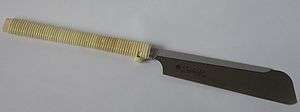Japanese saw

The Japanese saw or nokogiri (鋸) is a type of saw used in woodworking and Japanese carpentry that cuts on the pull stroke, unlike most European saws that cut on the push stroke. Japanese saws are the best known pull saws, but they are also used in Turkey, Iran, Iraq and Nepal. Among European saws, both coping saws for woodworking and jeweler's saws for metal working also cut on the pull stroke like Japanese saws. Cutting on the pull stroke is claimed to cut more efficiently and leave a narrower cut width (kerf). On the other hand, a pull stroke does not easily permit putting one's body weight behind a stroke. This can be readily solved by using a vise or clamping. Another disadvantage, due to the arrangement and form of the teeth , is that Japanese saws do not work as well on hardwoods as European saws do. Japanese saws were originally intended for comparatively soft woods like cypress and pine whereas European saws were intended for hard woods like oak and maple.
The popularity of Japanese saws in other regions of the world has resulted in the manufacture and production of a number of Japanese saws outside of Japan.[1]
Types of Japanese hand saws

- Douzukinoko 胴付鋸、胴突鋸
A type of backsaw. The Japanese means "attached trunk", thus a saw with a stiffening strip attached, i.e., a backsaw.
- Ryouba 両刃
Multi-purpose carpentry saw with two cutting edges. The Japanese means "double blade". There is a cross-cutting (yokobiki) 横挽き blade on one side and a ripping (tatebiki )縦挽き blade on the other.
- Kataba 片刃
A saw with teeth along only one edge, like a Western saw. These are supplied as either rip saw or cross-cut type blades. An advantage of this saw is that it is easy to use with a saw guide.
- Azebiki 畦挽(あぜびき)
A small ryōba saw used for cutting into the flat surface of a board rather than from the edge. The blade has a convex curve which can begin the cut anywhere on the surface.
- Mawashibiki (回し引き)
A thin saw used for cutting curves, the Japanese version of a keyhole saw. The name means "turning cut".
Other Japanese saws
- Oga
A large two-person saw used for ripping large boards in the days before power saws. One person stood on a raised platform, with the board below him, and the other person stood underneath them.
See also
References
- ↑ Chesapeake Light Craft, LLC. "The World's Best Handsaw: Cut Faster & More Accurately with the Japanese Saw - Razor Sharp Cuts on the Pull Stroke". Retrieved 25 June 2012.
External links
| Wikimedia Commons has media related to Japanese saws. |
- "Nokogiri". Japanese Architecture and Art Net Users System.
- Japanese saw at the Takenaka carpentry tools museum
- Japanese Hand Saw explanation and demonstration video by AskWoodMan